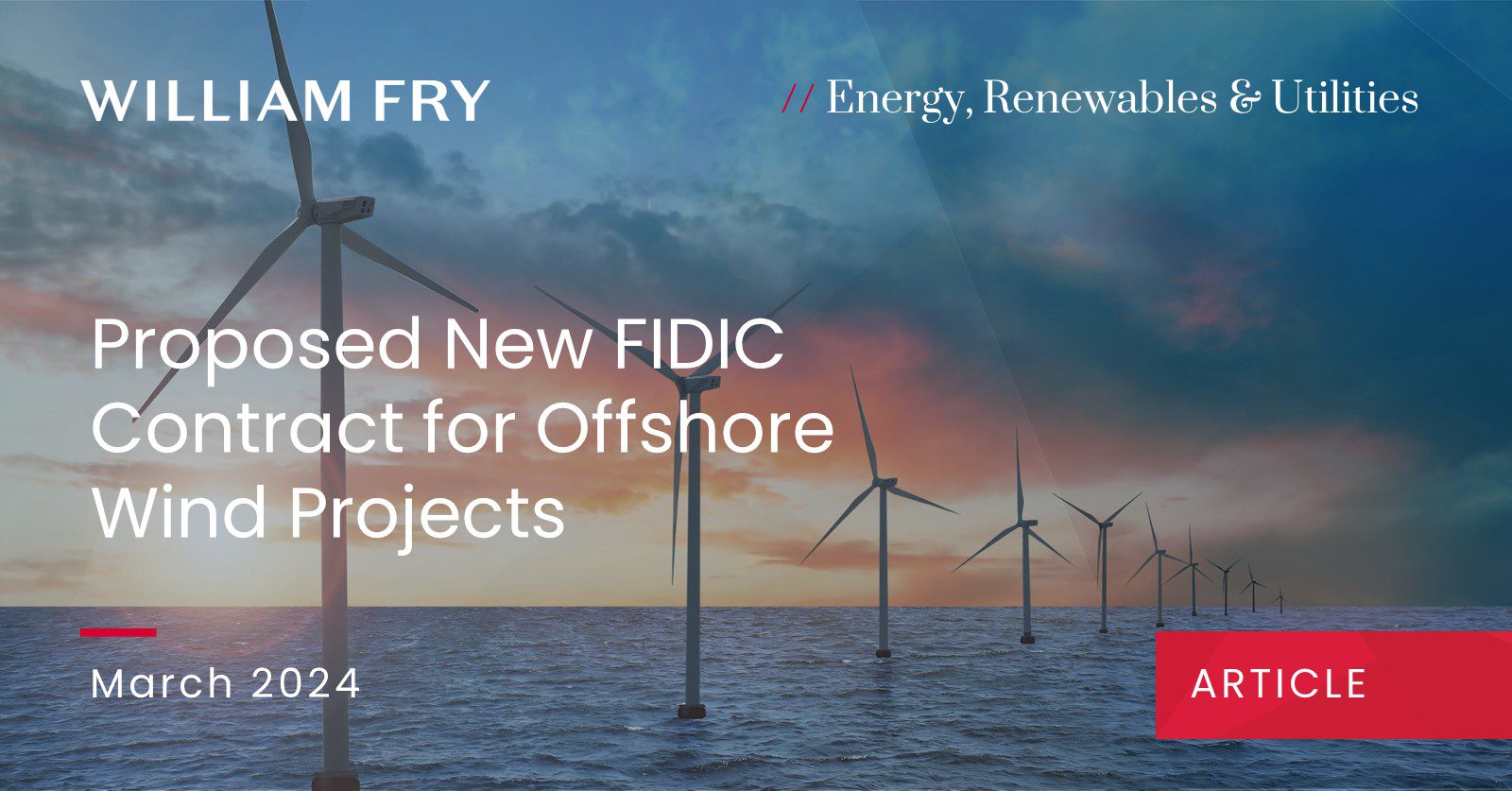FIDIC are developing a new standard form contract for offshore wind projects. What do you need to know?
Ireland’s offshore renewable energy (ORE) targets are ambitious. Harnessing our powerful wind resource offshore, the Irish Government is charting a path towards achieving Ireland’s and Europe’s targets for 2030, 2040 and 2050 for grid-connected and non-grid connected offshore wind, energy security and net carbon zero through various measures and policies. Construction industry capacity will need to grow significantly to meet these targets. While there has been much focus to date on the planning aspects of delivering Ireland’s ORE regime, the form of construction contract best suited to deliver on this needs to be considered.
FIDIC recently announced it was developing a new contract for offshore wind projects. It acknowledged the need for a balanced standard form given the sector growth internationally due to the net carbon zero agenda. Could this suit Ireland’s ORE pathway? We consider the type of contract currently used for this type of project and what should be considered in any new standard form contract.
Current contractual approach for offshore wind projects
Offshore windfarms are technically complex to design, construct and deliver. They lend themselves to an engineer, procurement and construct (EPC) or an engineer, procure, construct and install (EPCI) contract arrangement. Despite advances in offshore wind projects across Europe, to date there has been no standard industry contract form. Such projects are typically contracted based on heavily amended FIDIC conditions of contract (often the FIDIC Plant and Design-Build (Yellow Book) 1999 form) effectively resulting in virtually bespoke construction contracts.
Standard form construction contract for offshore wind projects
Acknowledging these issues, FIDIC is seeking to develop and publish what they refer to as a more balanced ORE construction contract to reflect industry needs and provide for proportional risk allocation between the employer and the contractor. FIDIC has assigned a dedicated taskforce to manage the development of this contract form.
What issues should the new offshore wind project contract consider?
- Cost: Offshore wind farm projects are costly. Supply chain issues, marine vessel availability, unique extension of time and delay events, inflation, and geopolitical status will all impact cost. A more balanced risk allocation arising from contractual compensation events impacting price will need to be addressed.
- Interface risk: Managing and mitigating interface risks between designers, contractors, specialist sub-contractors/suppliers for supply and installation and other external stakeholders (such as statutory bodies responsible for offshore transmission system such as EirGrid in an Irish context, energy/associated pricing regulation bodies such as the CRU, port authorities, lenders, insurers and others) will be challenging. Contractual measures will likely include a risk allocation matrix, project specific contract management boards and dispute escalation procedures to deal with live issues as they arise.
- Weather and climatic conditions: This will play a significant role in planning and delivering construction of Ireland’s offshore wind projects. It will impact nearly all operations, from transporting personnel and machinery, piling and laying foundations and cables, to supplying and installing turbines. The 1999 FIDIC Yellow Book edition and 2017 FIDIC Yellow Book edition treat the impacts of the foreseeability of weather and climatic conditions somewhat differently. The new offshore wind project contract may adapt this approach further. It will also need additional consideration in an Irish context.
- Risk of loss and damage: The regime of indemnities may adopt the “knock for knock” indemnity approach common in the Leading Offshore Energy Industry Competitiveness (LOGIC) suite of oil and gas contracts, to better manage risk allocation for loss and damage and the project insurances required.
- Site information and physical conditions: The challenges presented by the seabed site information available prior to contract and post contract are other issues will need to be managed.
Other contract options
The International Marine Contractors Association (IMCA) has also announced publication of a standard form contract for transport and installation works in offshore windfarm projects. In Ireland, there is a greater familiarity with the various forms of FIDIC contract in the on-shore energy/renewable energy sector including with bespoke amendments.
When will the new FIDIC contract for offshore windfarm projects be available for use?
FIDIC is targeting publication of the new FIDIC contract for offshore windfarm projects by the end of 2025.
Contact Us
Ireland is uniquely positioned to build capacity and maximise opportunities in offshore wind farm construction and development to meet its net carbon zero targets and guarantee its energy security. For more information or advice on the proposed contractual approaches to offshore wind farm projects, including FIDIC form contracts or otherwise, please contact Cassandra Byrne, Jarleth Heneghan, Liam McCabe, Fergus Devine or your usual William Fry contact.




